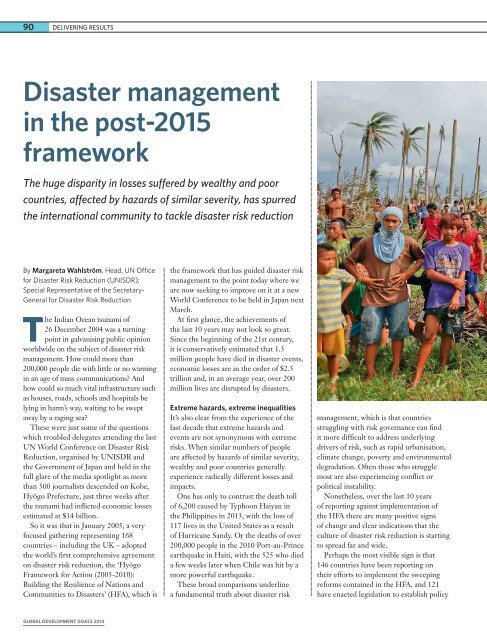FAMBB
FAMBB
FAMBB
Create successful ePaper yourself
Turn your PDF publications into a flip-book with our unique Google optimized e-Paper software.
90 DELIVERING RESULTSDisaster managementin the post-2015frameworkThe huge disparity in losses suffered by wealthy and poorcountries, affected by hazards of similar severity, has spurredthe international community to tackle disaster risk reductionBy Margareta Wahlström, Head, UN Officefor Disaster Risk Reduction (UNISDR);Special Representative of the Secretary-General for Disaster Risk ReductionThe Indian Ocean tsunami of26 December 2004 was a turningpoint in galvanising public opinionworldwide on the subject of disaster riskmanagement. How could more than200,000 people die with little or no warningin an age of mass communications? Andhow could so much vital infrastructure suchas houses, roads, schools and hospitals belying in harm’s way, waiting to be sweptaway by a raging sea?These were just some of the questionswhich troubled delegates attending the lastUN World Conference on Disaster RiskReduction, organised by UNISDR andthe Government of Japan and held in thefull glare of the media spotlight as morethan 500 journalists descended on Kobe,Hyõgo Prefecture, just three weeks afterthe tsunami had inflicted economic lossesestimated at $14 billion.So it was that in January 2005, a veryfocused gathering representing 168countries – including the UK – adoptedthe world’s first comprehensive agreementon disaster risk reduction, the ‘HyõgoFramework for Action (2005-2010):Building the Resilience of Nations andCommunities to Disasters’ (HFA), which isthe framework that has guided disaster riskmanagement to the point today where weare now seeking to improve on it at a newWorld Conference to be held in Japan nextMarch.At first glance, the achievements ofthe last 10 years may not look so great.Since the beginning of the 21st century,it is conservatively estimated that 1.3million people have died in disaster events,economic losses are in the order of $2.5trillion and, in an average year, over 200million lives are disrupted by disasters.Extreme hazards, extreme inequalitiesIt’s also clear from the experience of thelast decade that extreme hazards andevents are not synonymous with extremerisks. When similar numbers of peopleare affected by hazards of similar severity,wealthy and poor countries generallyexperience radically different losses andimpacts.One has only to contrast the death tollof 6,200 caused by Typhoon Haiyan inthe Philippines in 2013, with the loss of117 lives in the United States as a resultof Hurricane Sandy. Or the deaths of over200,000 people in the 2010 Port-au-Princeearthquake in Haiti, with the 525 who dieda few weeks later when Chile was hit by amore powerful earthquake.These broad comparisons underlinea fundamental truth about disaster riskmanagement, which is that countriesstruggling with risk governance can findit more difficult to address underlyingdrivers of risk, such as rapid urbanisation,climate change, poverty and environmentaldegradation. Often those who strugglemost are also experiencing conflict orpolitical instability.Nonetheless, over the last 10 yearsof reporting against implementation ofthe HFA there are many positive signsof change and clear indications that theculture of disaster risk reduction is startingto spread far and wide.Perhaps the most visible sign is that146 countries have been reporting ontheir efforts to implement the sweepingreforms contained in the HFA, and 121have enacted legislation to establish policyGLOBAL DEVELOPMENT GOALS 2014


